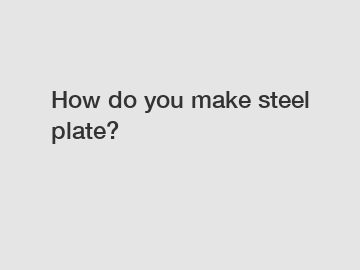How do you make steel plate?
Steel is one of the most commonly used materials in construction and manufacturing industries due to its strength, durability, and versatility. It is used to make a wide range of products, from vehicles and machinery to buildings and infrastructure. But have you ever wondered how steel plates are made? In this blog post, we will take a closer look at the process of making steel plates.
The process of making steel plates starts with the raw materials. The primary raw material used in steel production is iron ore, which is mined from the earth and then processed in blast furnaces to extract the iron. Other ingredients, such as limestone and coke, are also added to the blast furnace to help with the chemical reactions that occur during the smelting process.
Once the iron has been extracted from the ore and refined in the blast furnaces, it is then poured into molds to form large rectangular slabs called billets. These billets are then heated in a rolling mill to temperatures of around 1200 degrees Celsius to make them more workable. The billets are then passed through a series of rollers that gradually reduce their thickness and length to form steel plates of varying sizes and thicknesses.

The rolling process is crucial for creating steel plates of uniform thickness and quality. The plates may go through several passes in the rolling mill to achieve the desired dimensions and properties. The rollers exert tremendous pressure on the steel, causing it to deform and elongate until it reaches the desired thickness. The steel is also cooled during the rolling process to prevent it from becoming too brittle.
After the steel plates have been rolled to the desired thickness, they are then cut to the required size using shearing machines or flame cutting equipment. The plates may also undergo additional processing, such as heat treatment or surface finishing, to improve their properties and appearance. These processes may include quenching and tempering to increase hardness, or shot blasting and painting to enhance corrosion resistance.
Once the steel plates have been cut and processed to the required specifications, they are then inspected for quality to ensure they meet industry standards. This may involve testing the plates for strength, dimensional accuracy, and surface finish. Any plates that do not pass inspection may be recycled or reprocessed to meet the required standards.
Steel plates are used in a wide range of applications, from structural components in buildings and bridges to vehicle chassis and machinery parts. Their strength and durability make them ideal for withstanding high loads and harsh environments. Steel plates are also highly recyclable, making them a sustainable and eco-friendly choice for many industries.
In conclusion, the process of making steel plates involves a series of steps that transform raw materials into high-quality products with excellent mechanical properties. The rolling process is essential for shaping the steel into plates of uniform thickness and quality, while additional processing and testing ensure the plates meet industry standards. Steel plates are versatile and durable materials that play a vital role in various industries, from construction to manufacturing. The next time you see a steel plate, remember the complex process that went into making it and the crucial role it plays in our everyday lives.
For more information, please visit Checkered Steel Coil, high-quality hot rolled carbon steel coil, hot rolled carbon steel coil manufacturer.

Comments
0